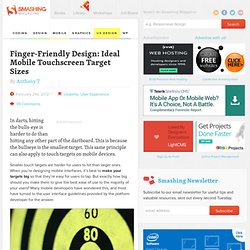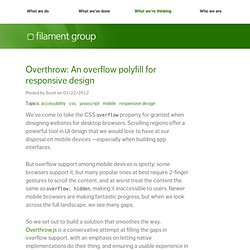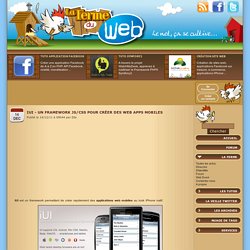

Problèmes de CSS avec l'iPad. Responsive Design Trends for the Mobile Web. It must be obvious by now that web designers are jumping onto the mobile bandwagon for almost every project. It’s commonplace to see people out and about playing around on their smartphones. And aside from native applications, much of this time is spent browsing the mobile web. We want to offer a great experience regardless of the device. Introduction à la performance pour le Web mobile. Préambule : le “Web mobile” n’existe pas.

Il n’y a qu’un seul Web et il ne change pas de visage selon votre périphérique de connexion. Le terme de “Web mobile” demeure cependant relativement parlant pour évoquer “le Web en situation de mobilité”, c’est pourquoi je me permets de l’employer au cours de cet article. Notre génération a jusque là été habituée à une évolution du Web prévisible et contrôlable : des écrans de bureau de plus en plus larges et des types de réseaux et connexions internet de plus en plus rapides. La démocratisation des périphériques mobiles (smartphones, tablettes et consorts) introduit de nouvelles contraintes et un inversement brutal de la tendance : les écrans deviennent subitement minuscules, et la connectivité en pâtit aussi : au mieux, votre mobile bénéficiera d’un réseau Wi-Fi, au pire… de rien du tout. En passant par les stades 3G et Edge / UTMS. » Responsive IMGs Part 2 — In-depth Look at Techniques Cloud Four Blog.
Responsive IMGs Part 2 — In-depth Look at Techniques In Responsive IMGs Part 1, I took a high-level look at what responsive IMGs are, the problem they are trying to solve, and the common issues they face.

In this post, I’m going to take a deeper look at the specific techniques being used to provide responsive IMGs and try to evaluate what works and doesn’t. If you haven’t read part 1, you may want to do so before reading this post as it will help explain some of the terms I use. When I started working on this project two months ago, I thought I would get to the end and be able to say, “Here are the three approaches that work best. Go download them and figure out how to integrate them into your systems.” What I’ve found is that there is no comprehensive solution. Because of this, the best thing we can do is understand the common elements and challenges so that we can start to pick the best parts of each for building our own solutions. So um… this is a long post. Abandoned approaches 1. Open Web Device. Responsive Navigation Patterns. Update: I’ve also written about complex navigation patterns for responsive design.

Top and left navigations are typical on large screens, but lack of screen real estate on small screens makes for an interesting challenge. As responsive design becomes more popular, it’s worth looking at the various ways of handling navigation for small screen sizes. Mobile web navigation must strike a balance between quick access to a site’s information and unobtrusiveness.
Here’s some of the more popular techniques for handling navigation in responsive designs: There are of course advantages and disadvantages of each method and definitely some things to look out for when choosing what method’s right for your project. Top Nav or “Do Nothing” Approach. Finger-Friendly Design: Ideal Mobile Touchscreen Target Sizes. Advertisement In darts, hitting the bulls-eye is harder to do than hitting any other part of the dartboard.

This is because the bullseye is the smallest target. This same principle can also apply to touch targets on mobile devices. Smaller touch targets are harder for users to hit than larger ones. When you’re designing mobile interfaces, it’s best to make your targets big so that they’re easy for users to tap. (Image credit: ogimogi) What the Mobile Platform Guidelines Say Apple’s iPhone Human Interface Guidelines recommends a minimum target size of 44 pixels wide 44 pixels tall.
Overthrow: An overflow polyfill for responsive design. Posted by Scott on 02/22/2012 Topics: accessibility css javascript mobile responsive design We’ve come to take the CSS overflow property for granted when designing websites for desktop browsers.

But overflow support among mobile devices is spotty: some browsers support it, but many popular ones at best require 2-finger gestures to scroll the content, and at worst treat the content the same as overflow: hidden, making it inaccessible to users. So we set out to build a solution that smoothes the way. Overthrow Project Site For cross-device overflow, no perfect solutions Overflow support is gaining rapidly in newer versions of mobile browsers.
This leaves us with a dilemma. First, we looked to a number of popular open-source projects that bring overflow support to touch devices to see whether any would satisfy our requirements. Most importantly, we wanted an approach that is designed to slowly kill itself off, allowing native implementations to do their thing as support becomes better and better. Ingrid - Un layout CSS fluide pour du responsive webdesign. Create your own iPhone, iPad and Android apps. Popular Online Mobile Testing Applications - Design, Mobile, Tools - Doulce. Mobile HTML5 - compatibility tables for iPhone, Android, BlackBerry, Symbian, iPad and other mobile devices. iUI - Un Framework JS/CSS pour créer des web apps mobiles. iUI est un framework permettant de créer rapidement des applications web mobiles au look iPhone natif.

Créer l'application web mobile d'un site est devenu quasi incontournable aujourd'hui si vous ne disposez pas d'un design responsive. iUI est un framework qui vous sera très utile pour créer rapidement vos web app mobile tout en gardant une ergonomie et un style proche des applications mobiles natives. Le framework est composé d'un ensemble de fichiers Javascript, CSS et images: La prise en main d'iUI se fait rapidement, en combinant HTML et classes. Il est ainsi relativement simple de créer un enchainement de pages: 01. <! 02. 03. 04. 05. 06. 07. 08. 09.